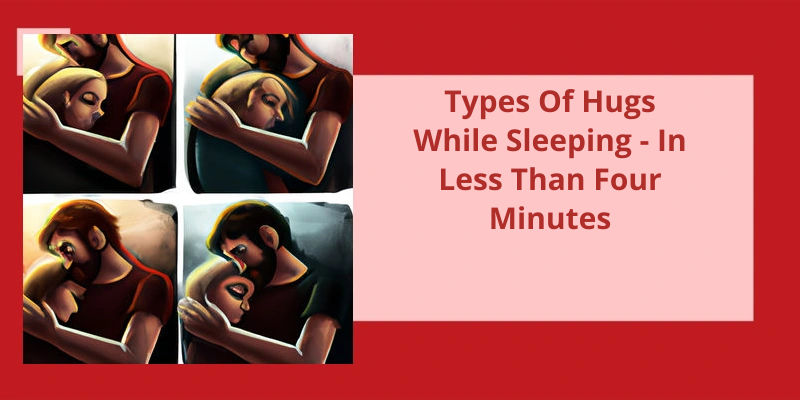Imagine a world where every night, as you drift off to sleep, you’re enveloped in a comforting hug. A hug that brings you warmth, a sense of security, and a deep feeling of connection. These hugs come in many shapes and forms, each with it’s own unique meaning and impact on your state of relaxation. In less than four minutes, this blog article will take you on a journey through the different types of hugs while sleeping, exploring the benefits they bring to your overall well-being. From the Spooning Hug to the Back to Back Hug, you’ll discover the power of touch and it’s ability to enhance your quality of sleep. So, join us as we delve into the world of sleep hugs and unlock the secrets to a restful night's slumber.
What Can I Hug While Sleeping?
When it comes to types of hugs while sleeping, one of the most popular choices is hugging a pillow. The pillow creates a connection with something tangible. This connection can be soothing for those who feel isolated or lonely when sleeping alone.
A pillow provides a sense of comfort and security. It can mimic the feeling of being embraced, providing a sense of warmth and protection. In fact, many people find it difficult to fall asleep without hugging a pillow. It becomes a natural part of their bedtime routine, enabling them to relax and drift off into a peaceful slumber.
Another option for a sleeping companion is a stuffed animal. Many adults still find comfort in hugging a teddy bear or a soft toy. The familiarity and nostalgia associated with these childhood treasures can bring a sense of peace and calmness. The softness of the stuffed animal can create a gentle, comforting sensation, making it easier to fall asleep and stay asleep throughout the night.
A body pillow is a long, rectangular pillow that can be hugged and wrapped around the body. It provides support to different parts of the body, such as the head, neck, back, and knees.
For those who prefer a more specialized sleeping companion, there are even pillows designed to resemble a persons arm or torso. These pillows are shaped to mimic the feeling of being held by someone. They offer a unique hugging experience, providing support and comfort while satisfying the need for physical closeness.
Different Types of Pillows: Memory Foam, Down, Buckwheat, or Contour Pillows May Provide Different Levels of Comfort and Support While Hugging.
When it comes to finding comfort while hugging in your sleep, the type of pillow you choose can make all the difference. There are a few different options to consider, such as memory foam, down, buckwheat, and contour pillows.
Memory foam pillows are known for their ability to contour to the shape of your body, providing a personalized level of support. They can be particularly helpful for those with neck and shoulder issues.
Down pillows, filled with soft feathers, offer a plush and cozy feel. They provide a gentle support and are ideal for those who prefer a softer hug.
Buckwheat pillows have a unique filling made from buckwheat hulls. These pillows conform to your body’s shape, offering both support and airflow, which can be beneficial for cooler sleeping.
Contour pillows are specifically designed to support the natural curvature of your neck and head. They offer firm support and can be a great choice for those experiencing neck or back pain.
Ultimately, the best type of pillow for hugging while sleeping will depend on your personal preferences and any specific needs you may have. It’s important to try out different options and find the one that provides the most comfort and support for you.
Sleeping positions can say a lot about a couple’s bond, and one particular position that showcases both tenderness and intimacy is the nuzzle. This sweet embrace involves one partner sleeping on their back while the other finds comfort resting their head on their partner’s chest. This position is often accompanied by a gentle intertwining of arms and legs, creating a sense of connection and protection.
Do Couples Hug While Sleeping?
Couples often cuddle and hug while sleeping, seeking comfort and emotional connection even in their slumber. One particular type of hug while sleeping is known as the nuzzle. In this position, one person lies flat on their back while the other person rests their head on the first persons chest. This intimate embrace creates a sense of security and closeness between partners, as their bodies intertwine in a loving gesture.
The nuzzle position not only involves chest-to-head contact but also includes the intertwining of arms and legs, further enhancing the feeling of being embraced and held tightly. The physical connection in this position conveys a deep emotional bond, as partners embrace each others vulnerabilities and provide a source of comfort and protection during their sleep.
The Benefits of Sleeping in a Hug Position for Couples
- Enhanced emotional connection
- Increased oxytocin levels
- Improved sleep quality
- Reduced stress and anxiety
- Promotes feelings of safety and security
- Alleviates discomfort and pain
- Enhanced intimacy and bonding
- Regulates body temperature
- Encourages better communication
- Boosts overall relationship satisfaction
Source: 19 Common Sleeping Positions for Couples and What They …
When it comes to physical expressions of affection, there’s often confusion between the terms “cuddle” and “hug.” While both involve close contact between two individuals, there are distinct differences between the two. A cuddle refers to a longer, more prolonged holding close of two individuals, usually for affection, comfort, or warmth. On the other hand, a hug, also known as an embrace, is a relatively brief application of pressure with the arms, typically conveying a sense of greeting or comfort.
Is Cuddling and Hugging Same?
Is cuddling and hugging the same thing? A cuddle is a more deeply intimate gesture that involves a prolonged holding close of two individuals for the purpose of comfort, affection, or warmth. It goes beyond a simple expression of care and creates a sense of deep intimacy and emotional connection between the two parties involved. Cuddling often involves intertwining limbs, resting heads on each others chests, and holding each other tightly. It’s a comforting and nurturing act that promotes a sense of security and love.
In contrast, a hug, also known as an embrace, is a more brief and immediate interaction. It typically involves the application of pressure using the arms from one person onto another. Hugs can be given to express a range of emotions, such as joy, comfort, support, or congratulations, and are often used as a form of greeting or farewell. Hugs convey a sense of warmth and care, but don’t necessarily create the same level of deep emotional connection as cuddling.
Both gestures have their unique benefits and can contribute to a sense of love, security, and emotional well-being in relationships. Whether it’s a tight embrace or a long, cozy cuddle, these gestures of physical affection can bring comfort and happiness to our lives.
Tips for Effective Cuddling and Hugging Techniques
- Start with a warm and friendly embrace.
- Keep your arms relaxed and open.
- Hold your partner gently, but not too tightly.
- Find a comfortable position for both of you.
- Focus on your partner’s body language and responses.
- Listen to their breathing and heartbeat.
- Use gentle strokes or caresses to create a soothing effect.
- Experiment with different cuddling positions.
- Give and receive equal amounts of affection.
- Communicate your desires and preferences with your partner.
- Remember to be present and fully engaged.
It’s a way for individuals to express their affection, comfort, and bond with another person. While hugging in bed can be a part of cuddling, it isn’t necessarily the same thing. Cuddling encompasses a broader range of intimate physical contact that goes beyond just a simple hug.
Is Hugging in Bed Cuddling?
In the context of hugging in bed, it can be seen as a form of cuddling. It’s a way for individuals to connect and feel protected, even in their sleep.
The types of hugs while sleeping can vary depending on the individuals involved and their level of intimacy. Some people prefer to sleep side by side, with their arms wrapped around each other in a tight embrace. This type of hug allows for maximum physical contact and can create a sense of togetherness throughout the night.
Others may opt for a more relaxed hug, with one person resting their head on the others chest or shoulder. This position can foster a sense of safety and relaxation, allowing both individuals to drift off into a peaceful sleep.
For those who enjoy spooning, sleeping in a spooning position can be a comforting and intimate way to hug while sleeping. This involves one person lying behind the other, with their arms wrapped around their partner. This position can create a sense of protection and closeness, as the individuals are physically connected and in sync.
It can promote feelings of warmth, affection, and emotional connection. Hugging releases oxytocin, a hormone associated with bonding and relaxation, providing a sense of calmness and contentment.
Whether it’s a tight embrace, a gentle hold, or a spooning position, hugging in bed can enhance the overall experience of sleep, fostering a deeper sense of intimacy and connection between partners.
For those who aren’t particularly inclined towards romantic partners or human companionship at bedtime, there are plenty of alternative options to satisfy your cuddling desires. One such option is a body pillow, which can become your ultimate sleep and binge-watching companion. If you prefer something softer, a fuzzy blanket can provide the perfect cuddle material. And if you’re seeking something a bit more adorable, a 3.15-inch stuffed animal can fit the bill. For those looking for a therapeutic touch, a weighted blanket may offer the comforting sensation you crave. If you find solace in the scent of freshly laundered clothes, a pile of fresh laundry can provide a cuddling experience like no other. Alternatively, a little stuffy toy can bring a cozy charm to your nighttime routine. And for those who desire the warmth and companionship of a living being, a pet can be the ultimate cuddle buddy. Lastly, if you’ve specific therapeutic needs, a therapeutic pillow may offer the perfect support and comfort for a restful night’s sleep. Whatever your cuddle preferences may be, there’s a perfect option out there for you.
What Can I Cuddle at Night?
For those who enjoy the comfort of cuddling at night but arent necessarily looking for a romantic partner, there are several options that provide the same cozy feeling. One popular choice is a body pillow, which can be your perfect companion for falling asleep and even binge-watching your favorite shows on Netflix. It’s long, cylindrical shape mimics the feeling of being held, providing a sense of security and comfort.
Another cuddly option is a fuzzy blanket, which offers warmth and softness as you drift off to sleep. It’s plush texture is reminiscent of snuggling up with someone, enveloping you in a comforting embrace. Additionally, a 3.15-inch stuffed animal can be a delightful sleeping companion, with it’s softness and compact size making it easy to hug and cuddle throughout the night.
For those seeking a therapeutic touch, a weighted blanket can provide a comforting and calming sensation. The gentle pressure distributed evenly across your body can help reduce anxiety and promote better sleep. Similarly, a pile of fresh laundry can offer a comforting scent and warmth, creating a soothing environment for a restful nights sleep.
Some individuals find solace in cuddling with a small, stuffed toy, such as a little stuffy. It’s cuddly nature can bring a sense of companionship and ease any feelings of loneliness. Alternatively, sharing your bed with a pet can provide emotional support and physical warmth. The presence of a furry friend can contribute to a sense of security and relaxation.
Lastly, a therapeutic pillow can offer the perfect cuddling substitute. These specialty pillows are designed to provide support and comfort to specific body parts, such as the neck, back, or knees. Their ergonomic design can help alleviate pain and promote better sleep, creating a cuddle-like experience tailored to your needs.
While human companionship is undeniably special when it comes to cuddling at night, there are various alternatives available for those who prefer a COVID-safe, non-romantic option. From body pillows to fuzzy blankets, stuffed animals to weighted blankets, these cozy companions can provide the comfort and support needed for a restful sleep. So, whether youre looking for a snuggle buddy or a therapeutic touch, theres something out there to fulfill your cuddling desires.
The Benefits of Cuddling for Overall Well-Being and Sleep Quality.
- Relieves stress and anxiety
- Boosts mood and happiness
- Enhances bonding and connection with others
- Reduces blood pressure and improves cardiovascular health
- Promotes better sleep quality
- Stimulates the release of oxytocin, the “love hormone”
- Reduces cortisol levels, a stress hormone
- Increases feelings of relaxation and comfort
- Improves immune system function
- Supports emotional well-being and mental health
Conclusion
From the tight and protective spooning embrace to the gentle and intimate forehead touch, each hug carries it’s own unique meaning and significance. Understanding these types of hugs enables us to deepen our understanding of human connection, fostering stronger bonds and promoting overall well-being. So, the next time you find yourself wrapped in a comforting embrace while asleep, take a moment to appreciate the language of touch and cherish the profound intimacy it can bring.






